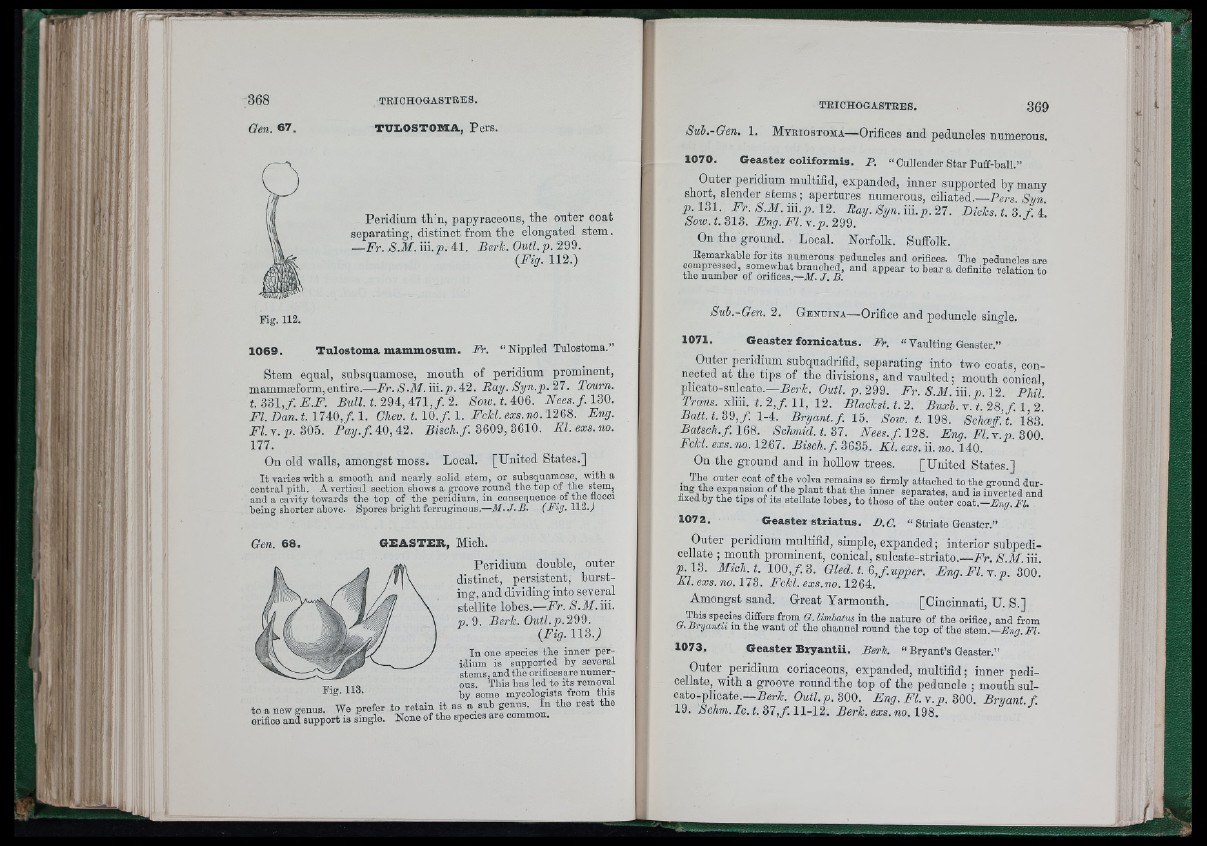
TBICHOGASTRES.
TULOSTOMA, Pers.
Peridium t f n , papyraceous, tbe outer coat
separating, distinot from tbe elongated stem.
— Fr. S .M. iii.75. 41. Berk. Outl.p. 299.
{Fig. 112.)
Kg. 112.
1 0 6 9 . T u lo s tom a m am m o sum . Fr. “ Nippled Tulostoma.”
Stem equal, subsquamose, moutb of peridium prominent,
mammieform,entire.—Fr. S .M . iii.p. 42. Bay. Syn.p. 27. Tourn.
t. 331,f . E .F . DmZZ. i.2 9 4 ,4 7 1 ,/. 2. Now. f. 406. N e e s .f.130.
F l .B a n . t .1740, f . l . Chev. t.lO . f . l . Fckl. exs.no.1268. Eng.
F l. T. p. 305. P a y .f. 40, 42. Bisch.f. 3609, 3610. E l. exs. no.
177.O
n old walls, amongst moss. Local. [United States.]
I t varies with a smooth and nearly solid stem, or snbsqnamose, with a
central pith. A vertical section shows a groove ronnd the top of the stem,
and a cavity towards the top of the peridinm, in consequence of the nocci
being shorter above. Spores bright ferruginous.—M .J .B , (Fig. 112.j
Gen. 68. G E Ä ST E R , Micb.
Kg. 113.
Peridium double, outer
distinct, persistent, bursting,
and dividing into several
stellite lobes.—Fr. N.M. iii.
P . O . Berk. Outl.p.299.
{Fig. 113.)
In one species the inner peridium
is supported by several
stems, and the orificesare numerous.
This has led to its removal
by some mycologists from this
, the rest the
to a new genus. We prefer to retain it as a sub genus^ In
orifice and support is single. None of the species are common.
Suh.-Gen. 1. M yriostoma—Orifices a n d p ed u n cles n um ero u s.
1 0 7 0 . G eä ste r c o lifo rm is . P. “ Cullender Star Puff-ball.”
Outer peridium multifid, expanded, inner supported by many
sbort, slender stems; apertures numerous, ciliated.—Pers. Syn
p. 131. Fr. S .M . i i i .p .12. Ray. Syn. iii. p . 27. Dicks, t.3 . f .4
S ow .t.3 l3 . E n g .F l.Y .p .2 9 9 .
Ou tbe ground. Local. Norfolk. Suffolk.
Remarkable for its numerous peduncles and orifices. The peduncles are
compressed, somewhat branched, and appear to bear a definite relation to
the number of orifices.—JA. J. B.
Suh.-Gen. 2. Genuina— Orifice and peduncle single.
1 0 7 1 . G eä ste r fo r n ic a tu s . Fr. “ Vaulting Geäster.”
Outer peridium subquadrifid, separating into two coats, connected
a t the tips of the divisions, and vaulted ; moutb conical,
pboato-sulcate.— Outl. p. 299. Fr. S.M. i i i .p .12. Phil.
Trans, xliii. t. 2 ,f. 11, 12. Blackst. t. 2. Buxh. v. t. 28, f . 1, 2.
B a tt.t.3 9 ,f. 1-4. B r y a n t.f 15. Sow. <.198. Schoeff.t. 18s!
B a ts c h .f.l6 8 . Schmid, t.37. N e e s .f.l2 8 . Eng. Fl y p 300
Fckl. exs.no.1267. B is c h .f 3635. Kl. exs.ii.no. 140.
On the ground and in hollow trees. [United States.]
The outer coat of the volva remains so firmly attached to the ground dur-
^ u ^ ® plant that the inner separates, and is inverted and
fixed by the tips of its stellate lobes, to those o fthe outer coat.—Ä y .Ä
1 0 7 2 . G eä ste r s t r ia tu s . B.C. “ Striate Geäster.”
Outer peridium multifid, simple, expanded; interior subpedi-
cellate ; inoutb prominent, conical, suloate-striato.—Dr. S.M. iii.
77. 13 . Mich. t. 100, f . 3 . Gled. t. 6,f.upper. E n g .F I .y . p. 300.
K l.e x s .n o .173. Fckl. exs.no.1264.
Amongst sand. Great Yarmouth. [Cincinnati, U. S.]
Tffiis species differs from G. UmUtus in the nature of the orifice, and from
(t. Mryantii in the want of the channel round the top of the sÎQm.—Eng. Fl.
1 0 7 3 . G eä ste r B r y a n tii. Berh. “ Bryant’s Geäster.”
Outer peridium coriaceous, expanded, multifid ; inner pedicellate,
with a groove round tb e top of tbe peduncle ; moutb sul-
cato-plicate.—D«rA O u tl.p .300. Eng. F I . y .p . 300. Bryant, f.
19. NcÄm./c.<. 37,/. 11-12. Berk. exs. no. 198.